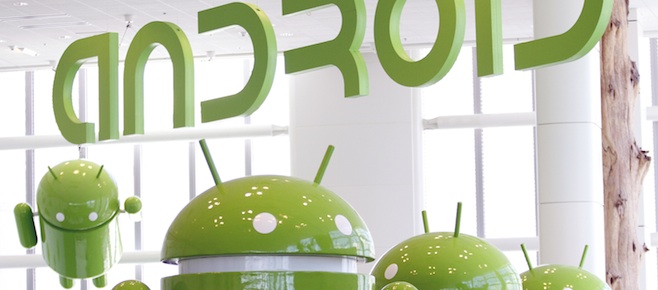Why cheap phones are a force of good
In other words: Android = free software = more competition among hardware makers
Android mascots are lined up in the demonstration area at the Google I/O Developers Conference in the Moscone Center in San Francisco, California, May 10, 2011. REUTERS/Beck Diefenbach (UNITED STATES – Tags: SCI TECH BUSINESS)
Share

In light of yesterday’s post about how the expensive iPhone may be counter-productive to societal goals, I thought it might be prudent to also touch on the other side as well.
When the first device powered by Google’s Android software was unveiled in 2008, it was intended to shake up how phones were made and sold and also how the mobile Internet would be used.
Four years later, Android is on the cusp of global domination and Google is well on its way to accomplishing those goals. While it’s customary to fear a rising power, this may just be a positive development for phone users, especially those in poorer countries.
“It’s about being better connected with the knowledge of the world and democratizing forces,” said John Lagerling, director of global partnerships for Android. “These are people who have never had a computer.”
Google’s foray into the phone game, however, isn’t exactly altruistic. In the early 2000s, the company realized that the computer-based Internet it dominated was quickly shifting onto mobile devices. Not wanting to cede its command of the online advertising market, it offered Android, an operating system on which Internet-enabled smartphones could run, to any device maker that wanted it.
While Android enabled web surfing, email and other Internet applications just like its competitors, it was radically different because it was free. Both Apple and BlackBerry maker Research In Motion keep their software to themselves, while Microsoft charges manufacturers to use a mobile version of Windows. Estimates have pegged its licensing fee at $23 to $30 per phone, which in the developing world is enough to make the devices unaffordable.
Manufacturers such as Samsung, Motorola and Sony Ericsson have since run with Google’s free option. As a result, Android is the market leader in the United States and Europe. In developing regions such as Africa, Latin America, China and India, where Android phones can sell for $80 or less on contract, Google either claimed market leadership in 2011 or will in 2012, according to tracking firm Gartner.
The secret, Lagerling says, is that Android has made Internet-enabled phones much cheaper to produce. Not only is the software free, it also drives competition between device makers, which further brings down prices.
“By doing Android, we’ve been able to enable more [manufacturers] to enter the game. It used to be the bar was higher,” he said. In emerging markets, that means lesser-known makers such as Spice Mobile and Micromax can compete with global brands such as Samsung and LG.
Android is also successfully displacing Nokia in many developing countries. While the Finnish company used to dominate in such places, analysts say it has failed to react to changing tastes and needs.
“It really comes down to the full touch screen. Nokia still doesn’t have full touch down to a certain price point, whereas Android does,” said Carolina Milanesi, research vice-president for Gartner. The importance of touch screens over keyboards, combined with simple-to-use graphical interfaces, is hard to overstate in countries where literacy rates are still low, she adds.
“People without a keyboard can input things and get their meaning across without having to type.”
While smartphone adoption is still low compared to the developed world, growth is exploding in emerging markets. In Africa, for example, smartphones account for only three per cent of all mobile devices, but the percentage is expected to jump to 15 per cent by 2015, according to Informa Telecoms & Media.
The devices are simpler and don’t pack the latest super-high-resolution screens and cameras, like they do in North America. Users are also considerably less reliant on apps, which means they use their smartphones mainly for web surfing and email, but that’s still enough to change lifestyles.
Cheaper smartphones enable things “like what’s the going market rate for the crop or the foods that I gather every day, and knowing that before you actually go to the market,” Lagerling said.
Given the cost factors, analysts expect Android to continue leading the big smartphone growth in emerging markets. Just as in the developed world, the devices are now becoming accessible to every-day people, not just business executives.
“Android is the right [operating system] for many consumers at the right time,” said Kevin Restivo, senior mobility analyst for technology tracking firm IDC. “The price and the ‘good-enough’ quality is opening up the consumer segment.”